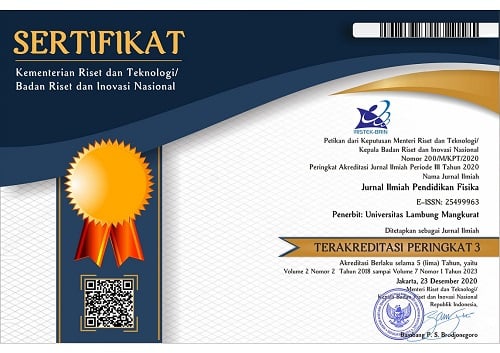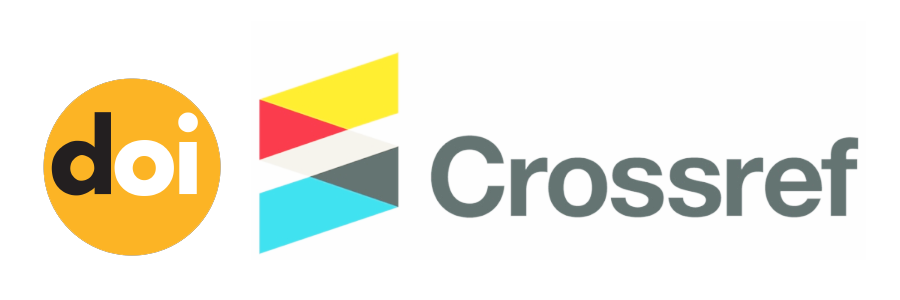Pengembangan Buku Ajar Fisika Sekolah berbasis Creative Responsibility untuk Mahasiswa Calon Guru
Abstract
Kreativitas menjadi sumber inovasi baru dalam menghadapi masalah kompleks di era globalisasi sekarang ini. Penting dilakukan mengarahkan setiap perkuliahan untuk melatihkan kreativitas mahasiswa. Produk kreativitas dapat maksimal, diperlukan nilai-nilai tanggung jawab agar melakukan yang terbaik. Penelitian ini bertujuan untuk mendeskripsikan validitas dan praktikalitas buku ajar fisika sekolah berbasis creative responsibility untuk mahasiswa calon guru. Jenis penelitian ini adalah penelitian pengembangan dengan model pengembangan Tessmer yaitu preliminary, self evaluation, expert review dan one-to-one, small group, dan field test. Subjek penelitian adalah 7 mahasiswa yang mengambil mata kuliah fisika sekolah. Intrumen pengumpul data berupa lembar validasi dan angket respon mahasiswa. Teknik analisis data menggunakan kualitatif yaitu tahap preliminary dan self evaluation, sedangkan pada tahap one-to-one dilakukan menggunakan analisis kuantitatif. Hasil penelitian didapatkan bahwa buku ajar yang dikembangkan menurut penilaian para pakar sudah valid dan juga sudah praktis berdasarkan respon mahasiswa terhadap buku ajar yang dikembangkan. Buku ajar fisika sekolah berbasis creative responsibility diharapkan dapat meningkatkan keterampilan berpikir kreatif dan tanggung jawab mahasiswa calon guru.
Creativity is a source of innovations in dealing with complex problems in the current era of globalization. It is important to direct each lecture to train students' creativity. For creativity products to be maximized, the values of responsibility are needed to do the best. This study describes the validity and practicality of creative responsibility-based school physics textbooks for student teacher candidates. This type of research is research and development with the Tessmer development model, namely preliminary, self-evaluation, expert review and one-to-one, small group, and field test. The research subjects were seven students who took the school physics course. Data collection instruments in the form of validation sheets and student response questionnaires. The data analysis technique used qualitative, namely the preliminary and self-evaluation stages, while the one-to-one stage was carried out using quantitative analysis. The results showed that the textbooks developed according to the expert's assessment were valid and practical based on student responses to the developed textbooks. School physics textbooks based on creative responsibility are expected to improve prospective teacher students' creative thinking skills and responsibility.
Keywords
Full Text:
PDFReferences
Arends, R. I. (2012). Learning to teach. McGraw-Hill Companies.
Arifuddin, M., Suyidno, S., Nur, M., & Yuanita, L. (2018). Menggali Potensi kreativitas ilmiah mahasiswa melalui model creative responsibility based learning. In Seminar Nasional Pendidikan (pp. 170–179).
Blašková, M. (2014). Influencing academic motivation, responsibility and creativity. Procedia-Social and Behavioral Sciences, 159, 415–425.
Cahyani, A. E. M., Mayasari, T., & Sasono, M. (2020). Efektivitas e-modul project based learning berintegrasi stem terhadap kreativitas siswa smk. Jurnal Ilmiah Pendidikan Fisika, 4(1), 15. https://doi.org/10.20527/jipf.v4i1.1774
Cohen, L. M., & Ambrose, D. (1999). Adaptation and creativity. In Encyclopedia of creativity, 1(1), 9–22).
Dewi, S., Rizal, S., & Johar, R. (2019). Pengembangan modul matematika diskrit berbantuan software wxmaxima. Jurnal Peluang, 7(2), 56–65. https://doi.org/10.24815/jp.v7i2.13747
Giancoli. (2001). Physics for scientists and engineers.
Hu, W., & Adey, P. (2010). A scientific creativity test for secondary school students. International Journal of Science Education, 24(4), 389–403.
Mentari, I., Zainuddin, Z., & Misbah, M. (2016). Pengembangan perangkat pembelajaran fisika berorientasi kemampuan berpikir kreatif pada pokok bahasan zat dan wujudnya di smp negeri 15 banjarmasin. Berkala Ilmiah Pendidikan Fisika, 4(2), 99. https://doi.org/10.20527/bipf.v4i2.1047
Mukhopadhyay, R., & Sen, M. K. (2013). Scientific creativity- A new emerging field of research: Some considerations. International Journal of Education and Psychological Research, 2(1), 1–9.
OECD, P. (2014). Result: Creative problem solving students’ skills in tackling real -life problems (Volume V).
Ridwan, S. (2019). Intellectual capital dan knowledge management dalam inovasi dan kreasi media pembelajaran berbasis kemampuan 4c dan literasi. Proceedings of The ICECRS, 2(1), 75–81. https://doi.org/10.21070/picecrs.v2i1.2414
Rif’at, M. F., Wati, M., & Suyidno, S. (2021). Mengeksplorasi tanggung jawab dan kreativitas ilmiah peserta didik melalui creative responsibility based learning. Journal of Banua Science Education, 2(1), 15–24.
Rif ’at, M. F., Wati, M., & Suyidno, S. (2020). Developing students’ responsibility and scientific creativity through creative responsibility based learning in learning physics. Berkala Ilmiah Pendidikan Fisika, 8(1), 12. https://doi.org/10.20527/bipf.v8i1.7879
Rohman, A., & Ain, T. N. (2020). Textbook design on temperature and thermodynamic based on problem solving blended learning model. Journal of Physics: Conference Series, 1594(1). https://doi.org/10.1088/1742-6596/1594/1/012025
Suacamram, M. (2019). Developing creativity and entrepreneurship of undergraduate students through a field trip overseas. International Journal of Instruction, 12(1), 591–606. https://doi.org/10.29333/iji.2019.12138a
Suranti, N. M. Y., Gunawan, G., & Sahidu, H. (2017). Pengaruh model project based learning berbantuan media virtual terhadap penguasaan konsep peserta didik pda materi alat-alat optik. Jurnal Pendidikan Fisika Dan Teknologi, 2(2).
Suratno, S., Komaria, N., Yushardi, D., & Wicaksono, I. (2019). The effect of using synectics model on creative thinking and metacognition skills of junior high school students. International Journal of Instruction, 12(3), 133–150.
Suyidno, S., Nur, M., Yuanita, L., Sunarti, T., & Prahani, B. (2016). Tanggung jawab mahasiswa jurusan pmipa universitas lambung mangkurat dalam pembelajaran fisika. Vidya Karya, 31 (2).
Suyidno, N., M., Y., L., P., K., B., & Jatmiko, B. (2017). Effectiveness of creative responsibility based teaching model on basic learning physics to increase student’s scientific creativity and responsibility. Journal Baltic Science Education, 17(1), 136–151.
Suyidno, S, & Nur, M. (2015). Pemahaman kreativitas ilmiah mahasiswa dalam pembelajaran kreatif pada mata kuliah fisika dasar. In Prosiding Seminar Nasional Pendidikan Sains (pp. 1361–1366).
Suyidno, Suyidno, Susilowati, E., Arifuddin, M., Misbah, M., Sunarti, T., & Dwikoranto, D. (2019). Increasing students’ responsibility and scientific creativity through creative responsibility based learning. Jurnal Penelitian Fisika Dan Aplikasinya (JPFA), 9(2), 178. https://doi.org/10.26740/jpfa.v9n2.p147-157
Tessmer, M. (1993). Planning and conducting formative evaluation. Routledge.
Trianggono, M. M., & Yuanita, S. (2018). Karakteristik keterampilan berpikir kreatif dalam pemecahan masalah fisika berdasarkan gender. Jurnal Pendidikan Fisika Dan Keilmuan, 4(2), 98–106.
DOI: https://doi.org/10.20527/jipf.v6i1.4306
Refbacks
- There are currently no refbacks.
Indexed by: Jurnal Ilmiah Pendidikan Fisika is licensed under a creative commons attribution-share alike 4.0 international license
Statistics Counter |

















